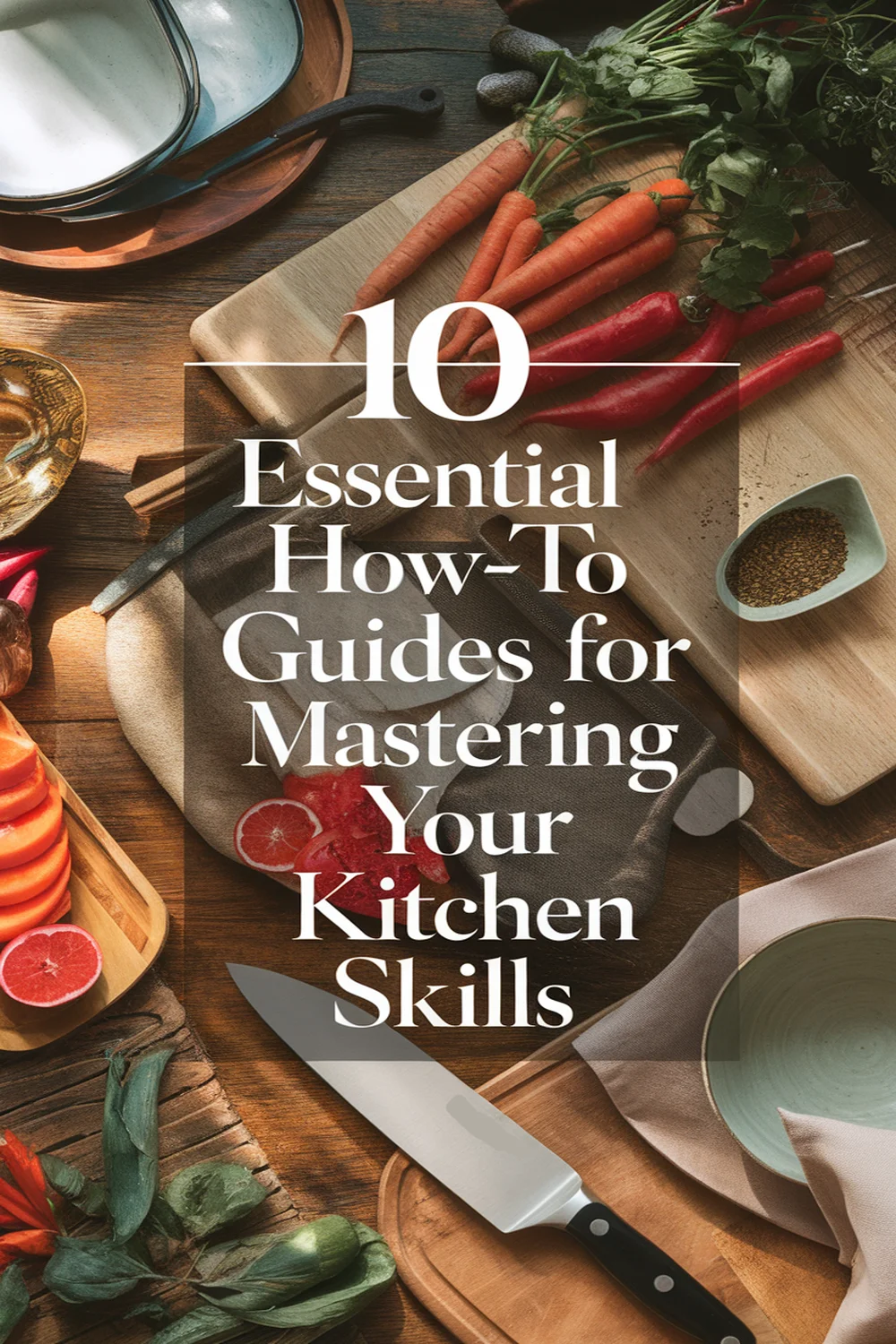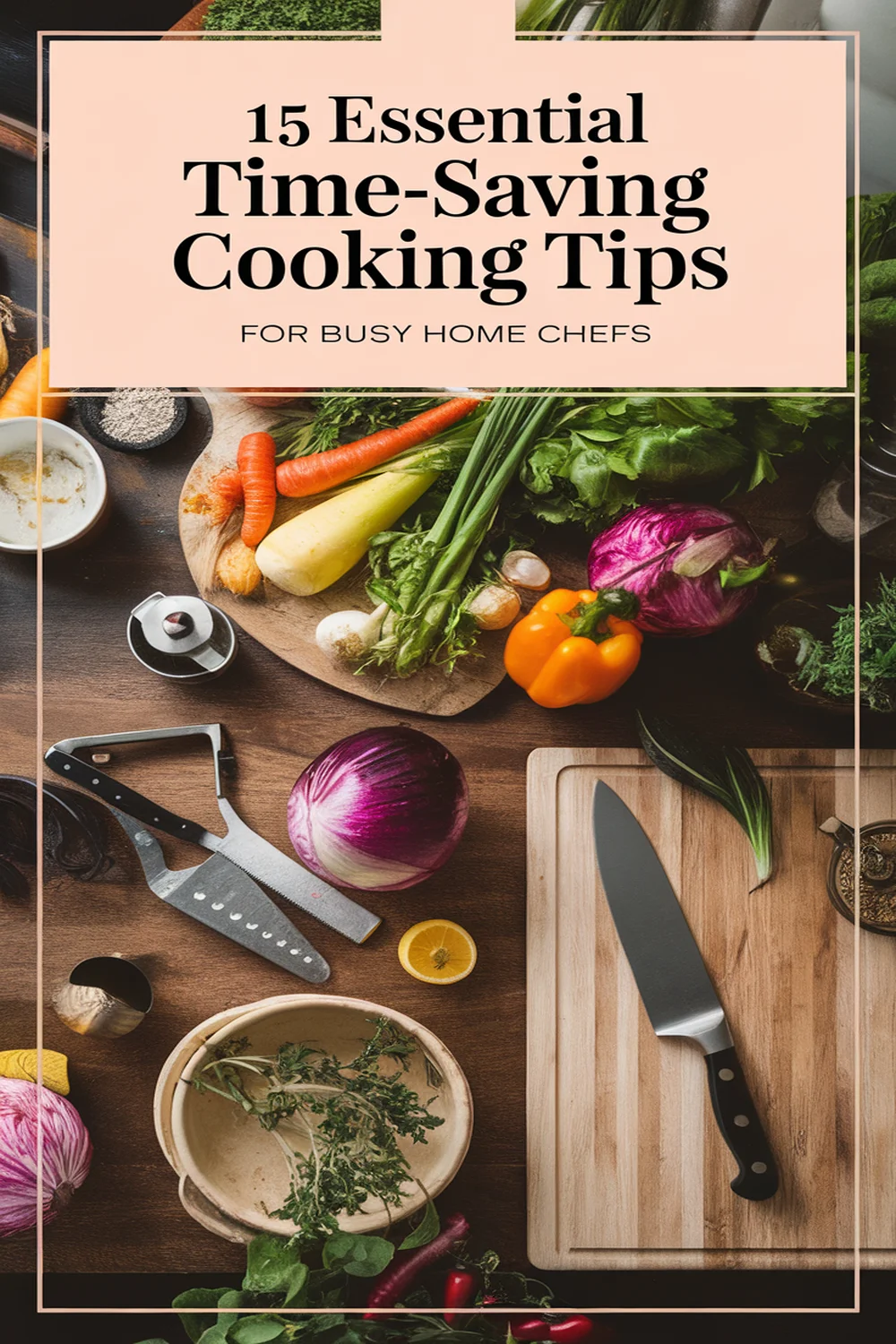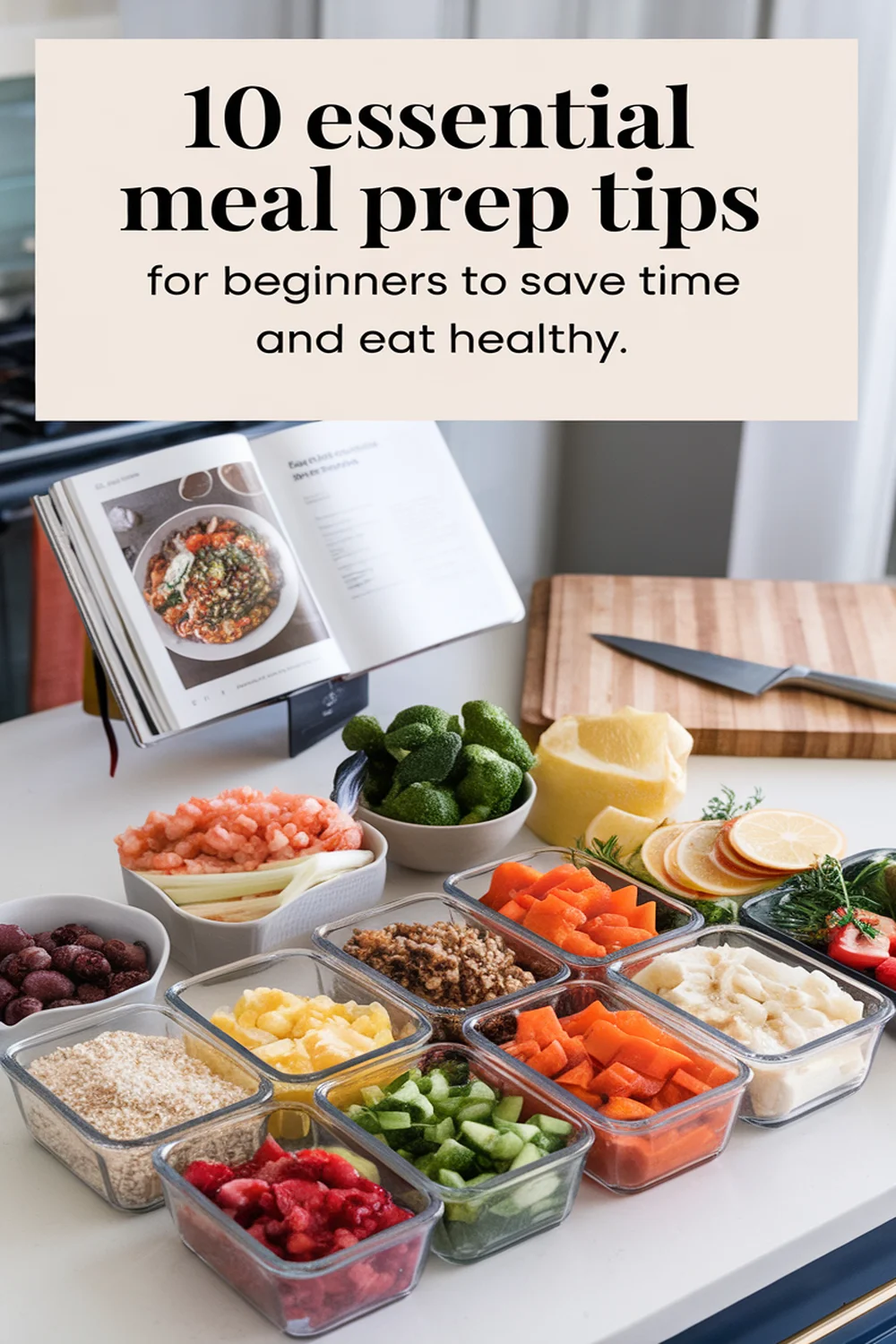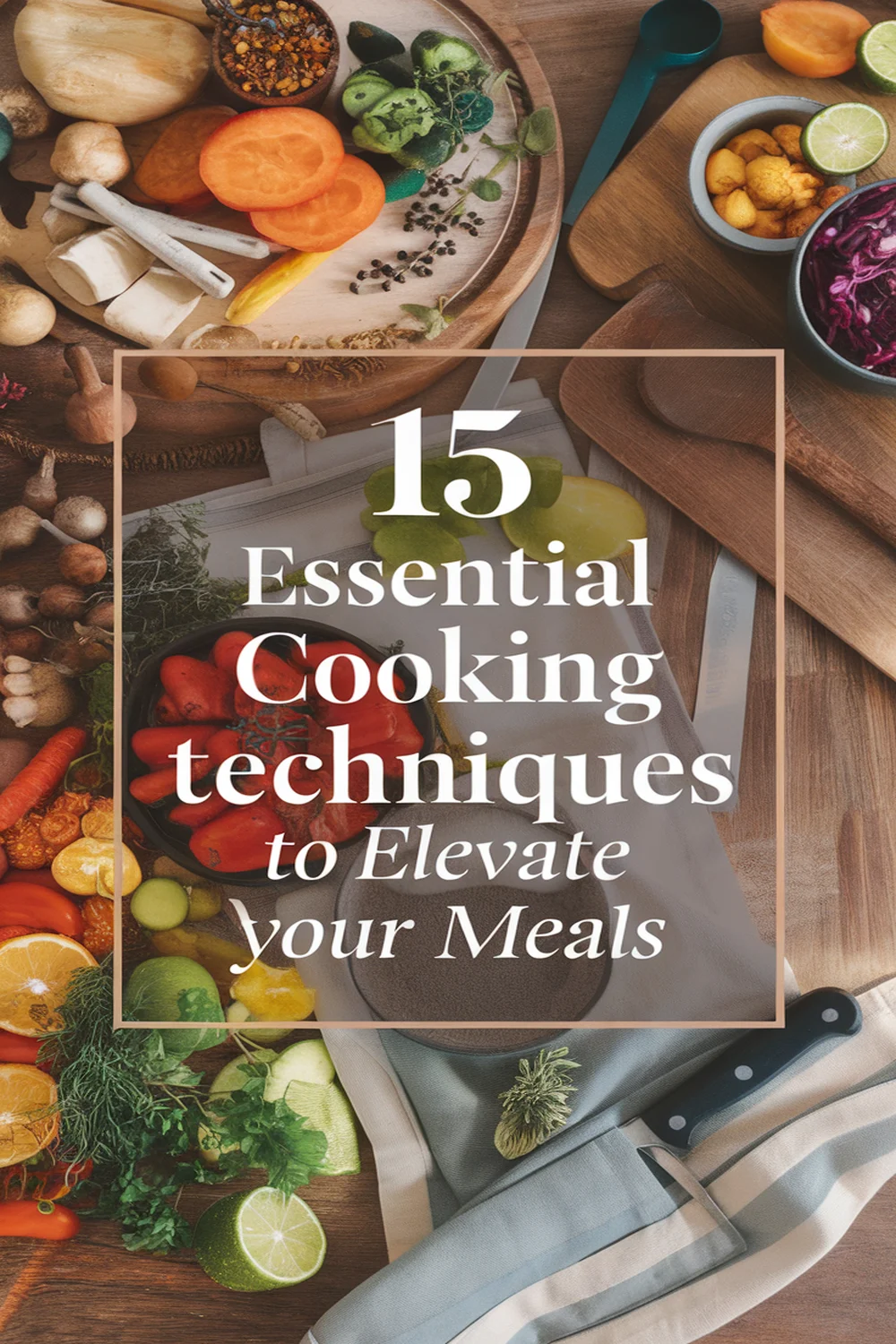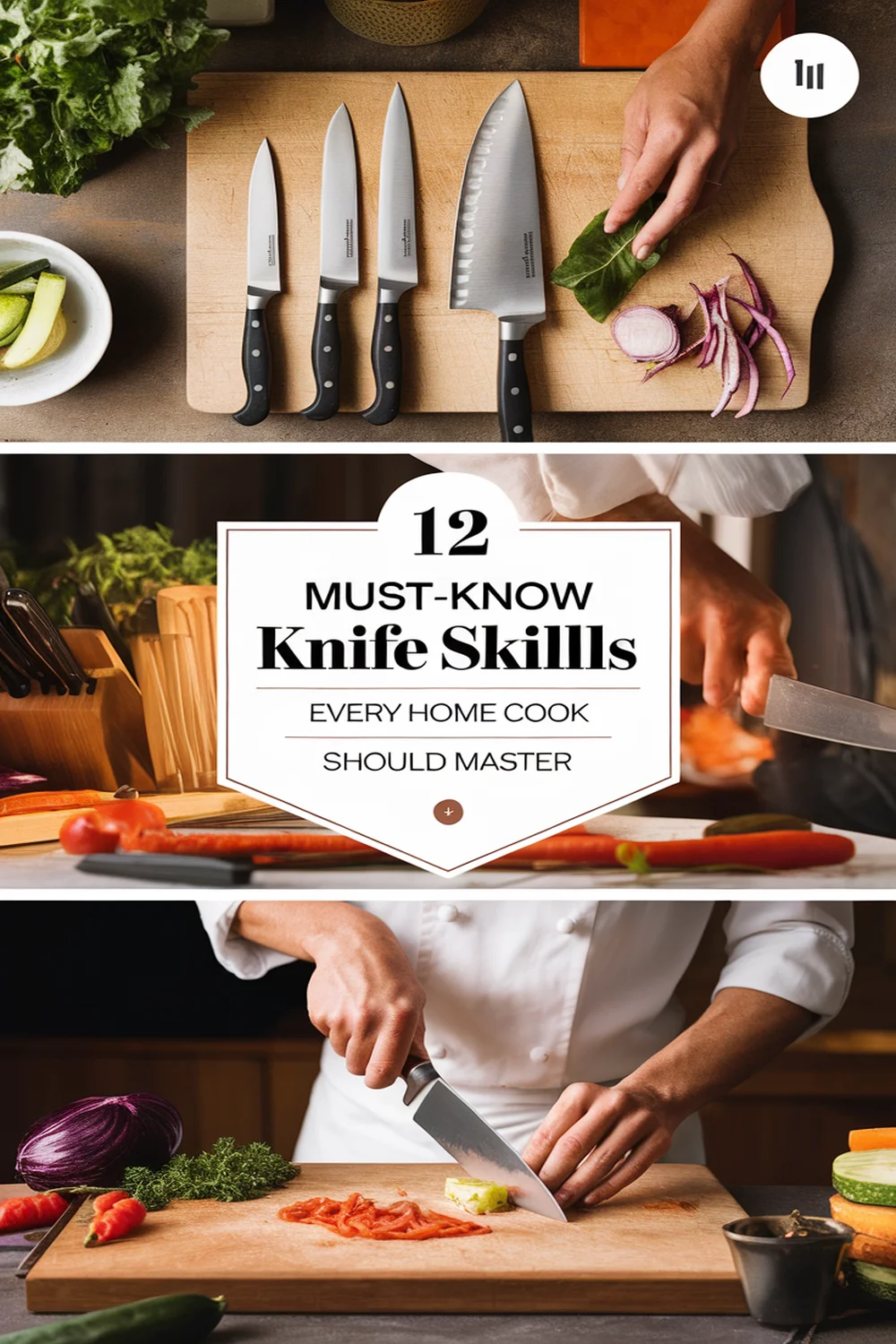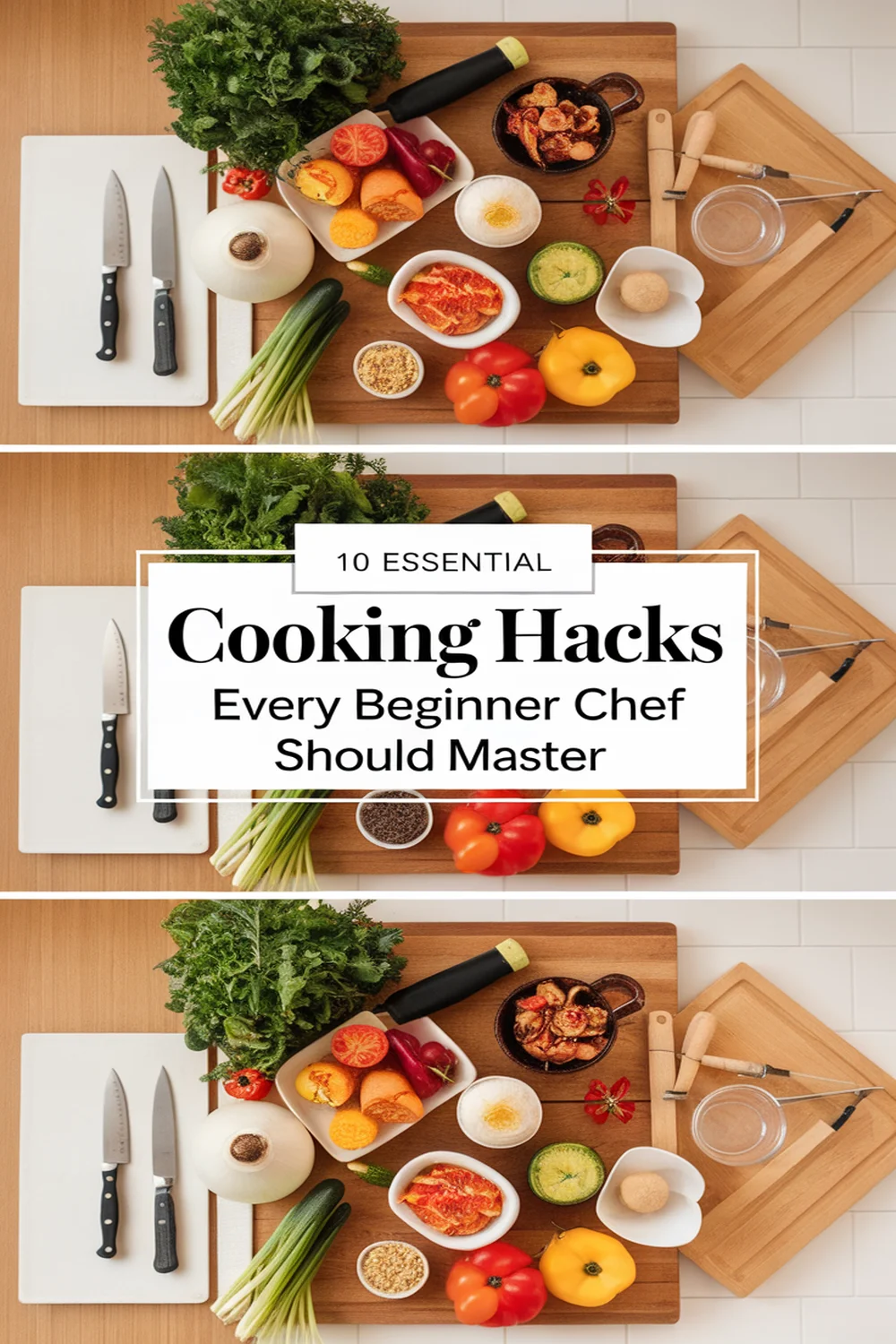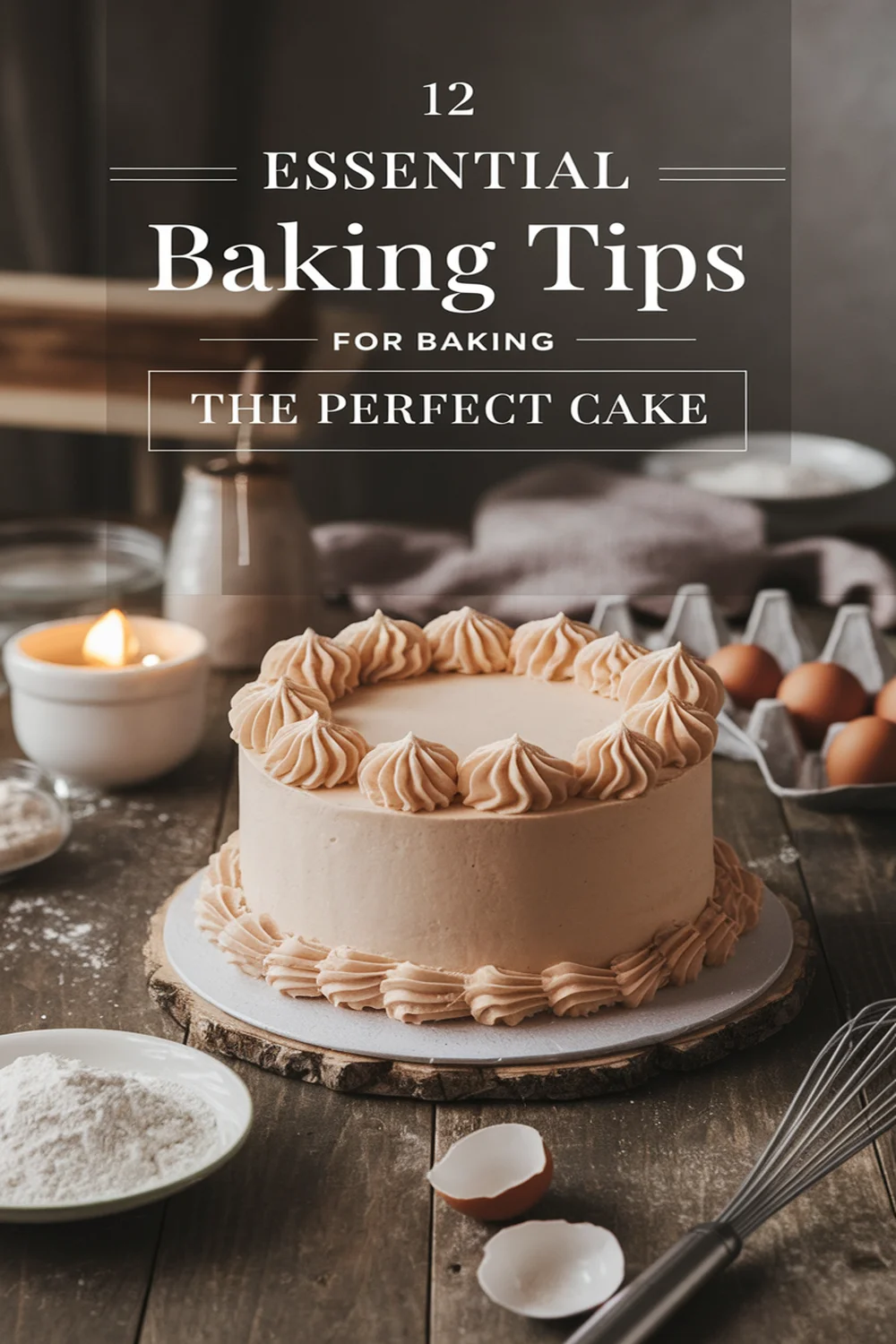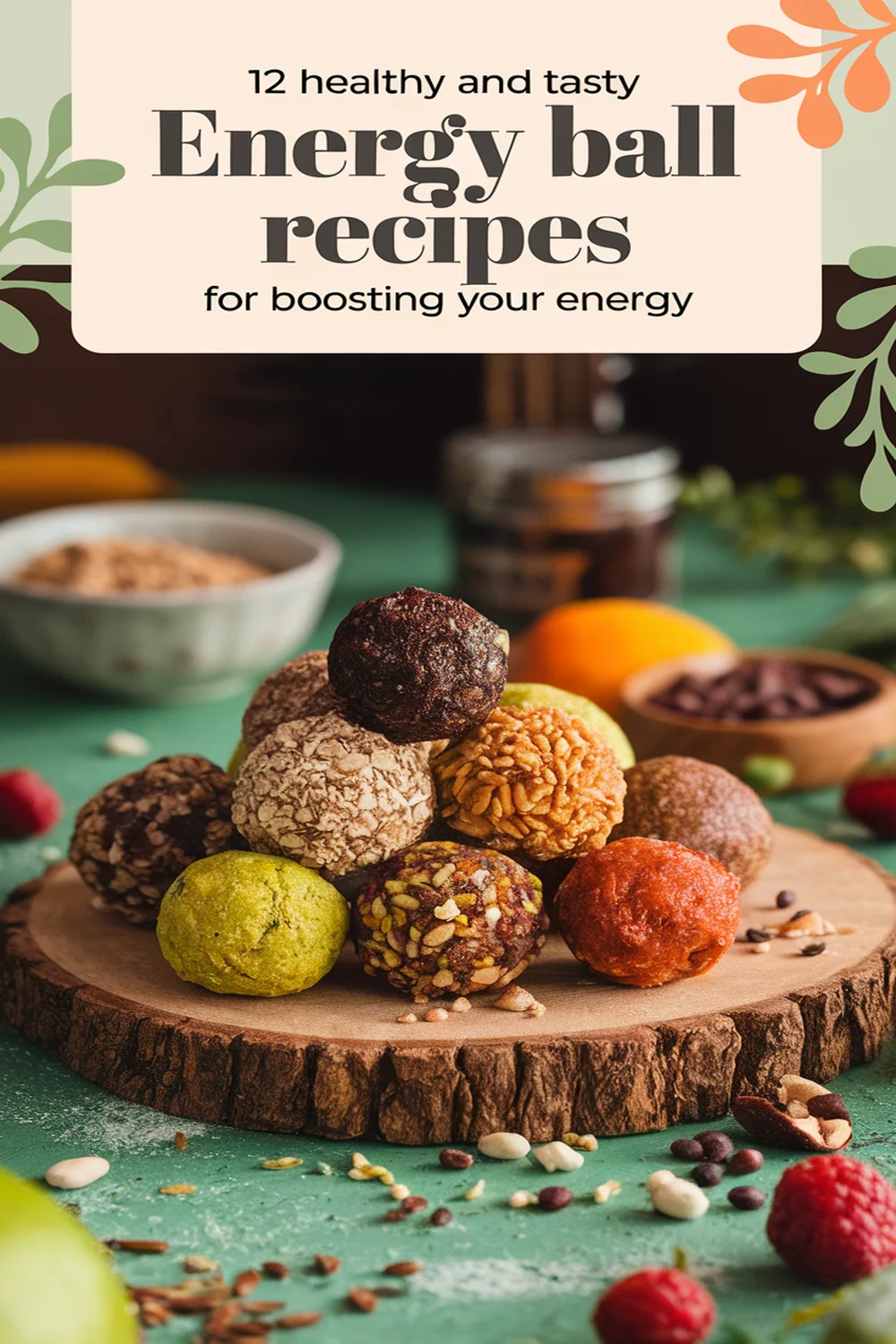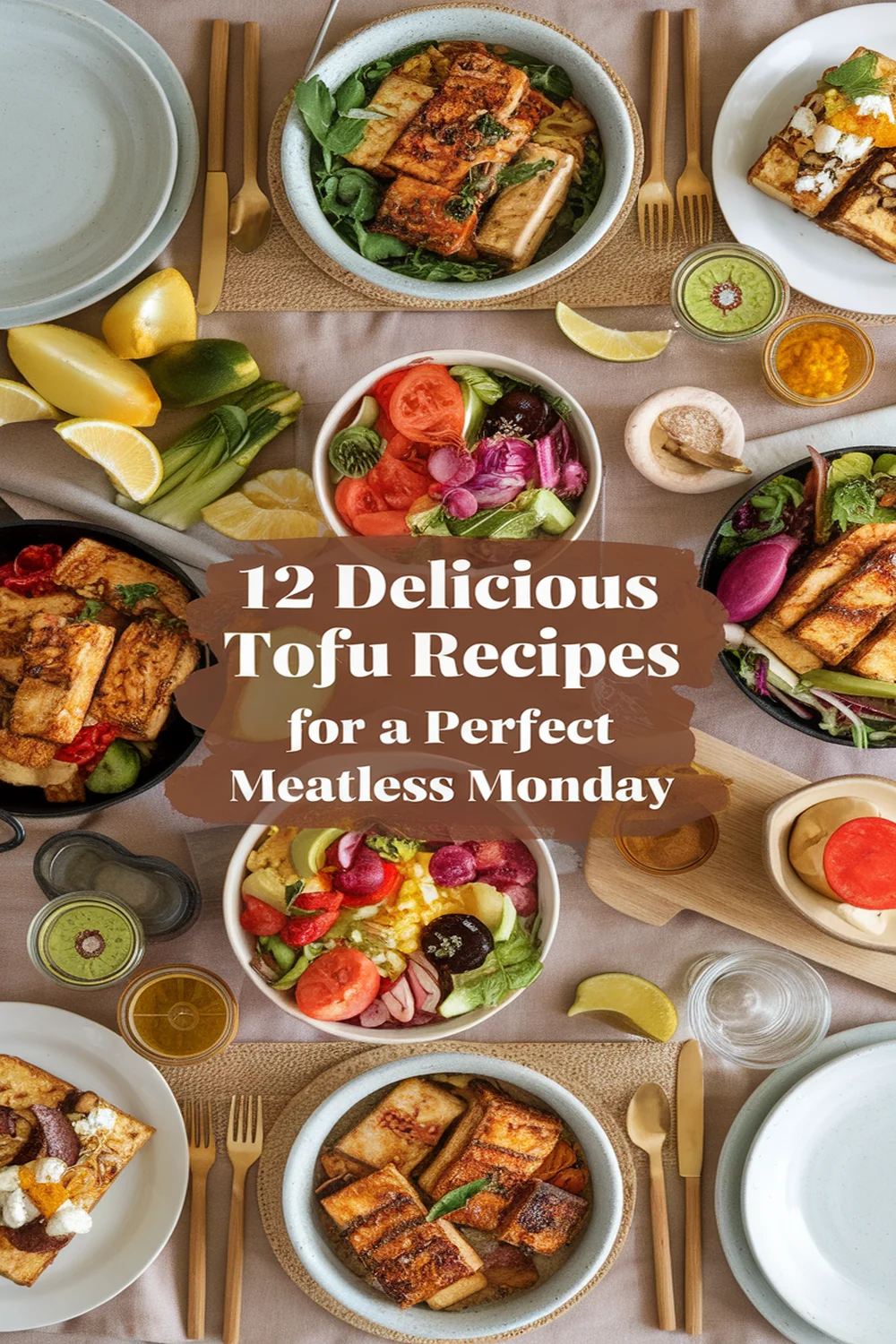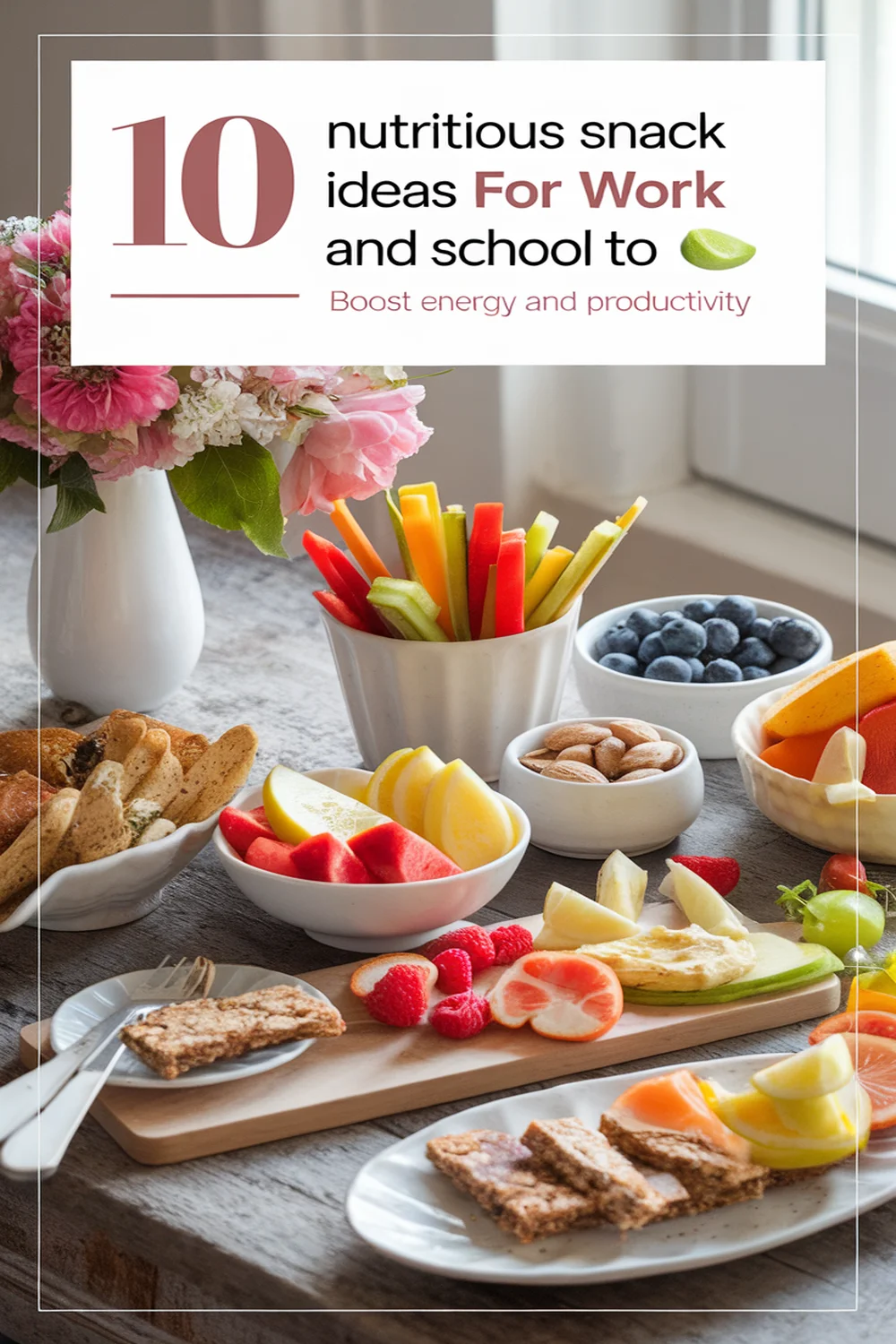This post may contain affiliate links. Please read our policy page.
To master your kitchen skills, start by understanding essential tools and equipment. Next, learn proper knife techniques for safe and efficient cutting. Meal prep will save you time, while mastering different cooking methods, like boiling and baking, enhances flavors. Build flavor with the right herbs and spices, and don’t overlook the importance of sauces. Clean food safety practices help prevent illness, and creative plating can make every dish a masterpiece. Keep exploring for even more tips!
Understanding Kitchen Tools and Equipment
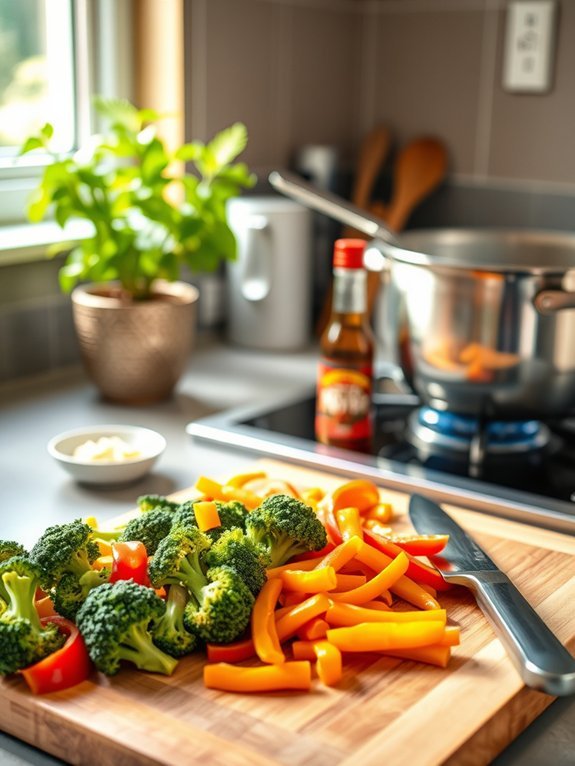
Cooking is an art, and having the right kitchen tools and equipment can make a world of difference in your culinary creations. Understanding how to properly use these tools not only enhances the flavor of your dishes but also makes the cooking process more efficient and enjoyable.
Whether you’re sautéing, boiling, or baking, each tool in your kitchen has its unique purpose and functionality, making it vital to get familiar with them before diving into any recipe.
One basic yet versatile dish to cook while practicing your kitchen skills is a simple vegetable stir-fry. This dish allows you to experiment with various cooking techniques and utilizes a range of kitchen tools, such as knives, cutting boards, a skillet, and spatulas. Stir-frying requires high heat and quick cooking, which is why having your ingredients prepped and tools ready is key to achieving the perfect dish.
- 2 cups of mixed vegetables (bell peppers, broccoli, carrots)
- 1 tablespoon of vegetable oil
- 2 cloves of garlic, minced
- 1 tablespoon of soy sauce
- Salt and pepper to taste
- Cooked rice or noodles (for serving)
In a large skillet or wok, heat the vegetable oil over medium-high heat. Once the oil is hot, add the minced garlic and sauté for about 30 seconds, making sure it doesn’t burn. Then, throw in the mixed vegetables and stir constantly for about 5 to 7 minutes until they’re tender-crisp. Add the soy sauce along with salt and pepper to taste, stirring everything together until well combined. Serve hot over cooked rice or noodles.
When making a stir-fry, it’s important to prepare all your ingredients before you start cooking, as the process moves quickly. Cut your vegetables into uniform sizes to guarantee they cook evenly.
Feel free to customize the dish by adding protein sources like chicken, beef, or tofu, adjusting the cooking time accordingly. A splash of sesame oil or a sprinkle of sesame seeds can add extra flavor and texture to the finished dish.
Essential Knife Skills for Every Cook
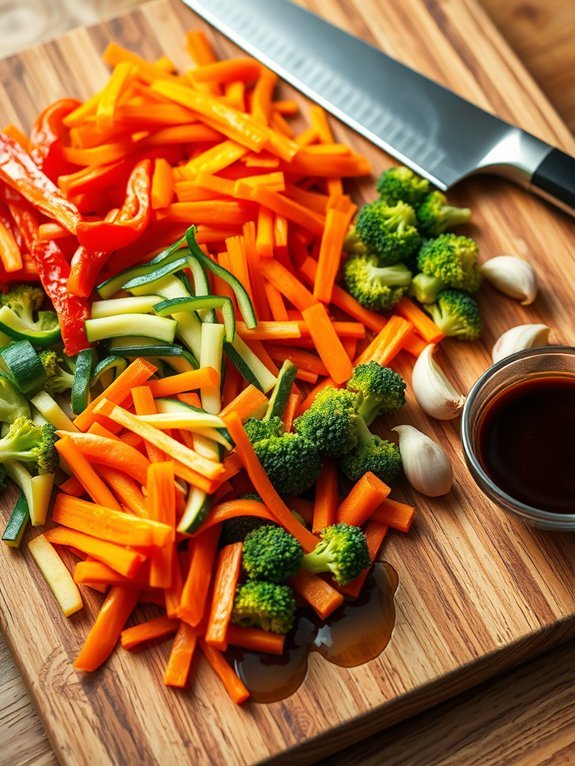
When it comes to mastering essential knife skills, understanding how to properly chop, slice, and dice a variety of ingredients is key to becoming a confident cook. Each technique not only affects the appearance of your dishes but can also influence their cooking times and flavors.
Whether you’re preparing a simple vegetable stir-fry or a complex gourmet meal, knowing how to handle your knife effectively can enhance your culinary creations greatly.
In this recipe, we’ll focus on a fresh vegetable stir-fry that allows you to practice your knife skills while enjoying a flavorful dish. Featuring a colorful array of vegetables, this stir-fry isn’t only healthy but also a great way to showcase your newly honed skills.
Pair this with your choice of protein, or serve it as a satisfying vegetarian meal that celebrates vibrant, seasonal produce.
- 1 bell pepper
- 1 zucchini
- 1 carrot
- 1 cup broccoli florets
- 2 cloves garlic
- 2 tablespoons soy sauce
- 1 tablespoon olive oil
- Salt and pepper to taste
- Sesame seeds (for garnish)
Begin by preparing your vegetables. Use your knife skills to slice the bell pepper into thin strips, julienne the zucchini and carrot, and chop the broccoli into bite-sized pieces. Mince the garlic finely.
Heat the olive oil in a large skillet or wok over medium-high heat. Once hot, add the garlic and sauté briefly until fragrant before adding in the assorted vegetables. Stir-fry for about 5-7 minutes until they’re tender but still vibrant in color.
Pour in the soy sauce, season with salt and pepper, and cook for an additional minute to combine flavors.
Remember to maintain a proper grip on your knife; using a claw grip with the fingers tucked in will protect your digits while ensuring precision.
Always keep your knife sharp for the best results, as a dull knife is more dangerous and can lead to uneven cuts.
Practice your chopping and slicing techniques with various vegetables to increase your confidence. Don’t hesitate to experiment with different ingredients or add a protein of your choice to customize this stir-fry to your taste.
Recommended Items
Ready to enhance your culinary journey? Check out our favorite products and tools to get started!
Mastering the Art of Meal Prep
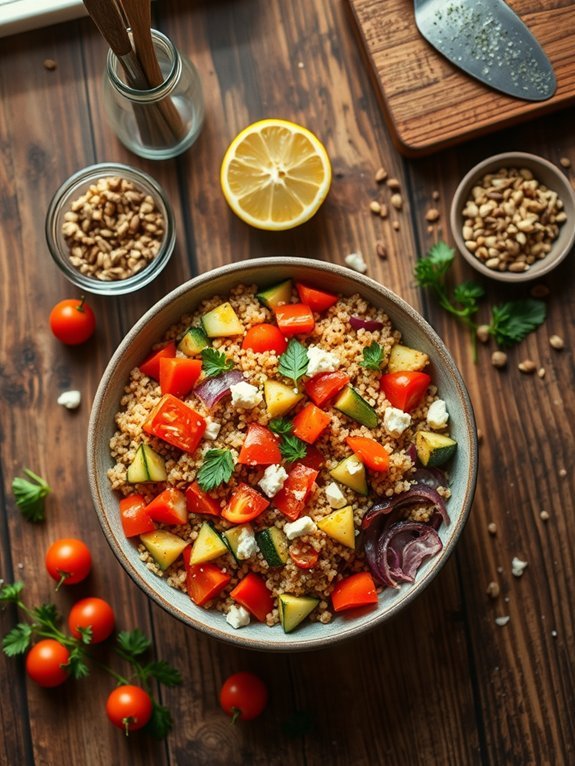
Meal prep is a game-changer that allows you to effortlessly enjoy wholesome, home-cooked meals throughout the week. By dedicating a few hours on the weekend or your day off, you can cook in bulk, portion out meals, and store them for quick access. This method not only saves time but also notably reduces food waste and helps manage your dietary goals more effectively.
The following recipe for a versatile quinoa and roasted vegetable bowl is perfect for meal prepping, as it’s nutritious, filling, and can easily be customized to suit your taste. This dish is packed with protein-rich quinoa, vibrant seasonal vegetables, and a zesty dressing that brings everything together. Feel free to swap out any of the veggies for your favorites or whatever you have on hand. You can also add proteins like grilled chicken, tofu, or chickpeas to further enhance the nutritional profile of your meal prep.
Once prepared, these healthy bowls can be stored in the fridge for up to five days, making them a fantastic option for hurried lunches or dinners.
Ingredients:
- 1 cup quinoa
- 2 cups vegetable broth (or water)
- 1 zucchini, diced
- 1 bell pepper, diced
- 1 cup cherry tomatoes, halved
- 1 red onion, chopped
- 2 tablespoons olive oil
- Salt and pepper, to taste
- 1 teaspoon garlic powder
- 1 teaspoon Italian seasoning
- ¼ cup fresh parsley, chopped
- ¼ cup feta cheese (optional)
- Juice of 1 lemon
In a large pot, rinse the quinoa under cold water and then add it to the vegetable broth. Bring to a boil, then reduce the heat to a simmer and cover, cooking for about 15 minutes or until the quinoa is fluffy and the broth is absorbed.
Meanwhile, preheat your oven to 425°F (220°C) and toss the diced zucchini, bell pepper, cherry tomatoes, and red onion with olive oil, salt, pepper, garlic powder, and Italian seasoning. Spread the vegetables on a baking sheet and roast for 20-25 minutes until they’re tender and slightly browned.
Once the quinoa and vegetables are ready, combine them in a bowl and add fresh parsley, feta cheese (if using), and lemon juice. Mix well and portion into meal prep containers.
To elevate your quinoa and roasted vegetable bowls, consider letting the flavors meld by allowing the meal prep containers to sit in the fridge overnight before consuming. For those who enjoy a bit of crunch, add a handful of nuts or seeds just before serving to keep them fresh.
Feel free to experiment with different dressing options like balsamic vinaigrette or tahini sauce for a unique twist each week. Finally, ensuring your vegetables are cut uniformly will help them cook evenly and provide consistent texture in your meal. Enjoy the benefits of meal prep by making these delicious bowls a staple in your dining routine!
Step-by-Step Cooking Guide
Cooking Methods: Boiling, Baking, and Beyond
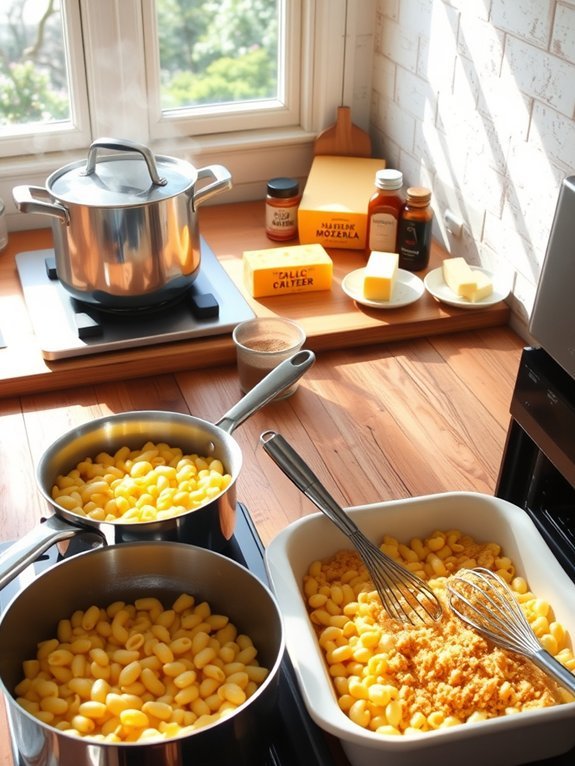
Cooking is an essential skill that elevates our daily meals, and mastering different cooking methods can make a significant difference in the flavors and textures of our dishes. While boiling is often seen as a basic technique, it’s a versatile method that can be used to prepare everything from hearty soups to perfectly cooked pasta.
Baking, on the other hand, transforms simple ingredients into delightful treats, enriching them with warmth and inviting aromas. Each method has its unique advantages that can enhance your culinary repertoire.
Let’s explore a delicious recipe to exemplify these cooking methods, focusing on a comforting dish: Baked Macaroni and Cheese. This classic dish combines the simplicity of boiling pasta with the decadent finish of baking cheese until bubbly and golden. The balance of creamy sauce and baked flavor creates an irresistible comfort food that’s easily adaptable for a variety of tastes.
Ingredients:
- 8 ounces elbow macaroni
- 2 cups shredded sharp cheddar cheese
- 1 cup shredded mozzarella cheese
- 3 tablespoons unsalted butter
- 3 tablespoons all-purpose flour
- 2 cups milk
- 1/2 teaspoon paprika
- 1/2 teaspoon garlic powder
- Salt and pepper to taste
- 1/2 cup breadcrumbs
Cook the elbow macaroni in a large pot of salted boiling water according to package instructions, usually around 8-10 minutes until al dente.
While the pasta is cooking, preheat your oven to 350°F (175°C). In a separate saucepan, melt the butter over medium heat, then whisk in the flour and cook for 1-2 minutes until lightly golden. Gradually add the milk, stirring continuously until the mixture thickens.
Remove from heat, then stir in the cheeses, paprika, garlic powder, salt, and pepper until smooth. Combine the drained pasta with the cheese sauce, then transfer to a greased baking dish. Sprinkle breadcrumbs on top, and bake for 25-30 minutes or until the top is crispy and golden.
For an extra flavor twist, consider adding cooked vegetables like broccoli or spinach to the macaroni before baking. You can also experiment with different cheeses, such as gouda or parmesan, to mix up the taste.
If you prefer a creamier texture, increase the amount of milk in the cheese sauce. Finally, allow the baked mac and cheese to rest for a few minutes before serving, which allows it to set and makes for easier slicing. Enjoy your homemade comfort food!
Flavor Building: Herbs, Spices, and Seasoning
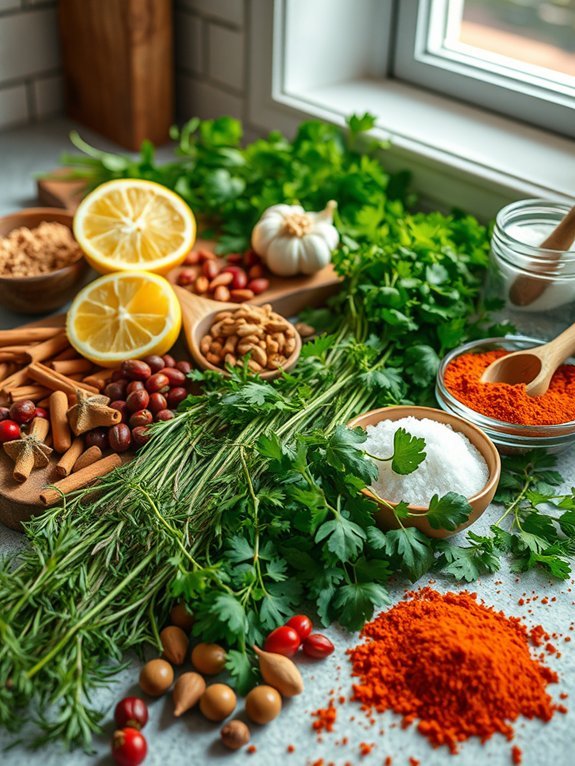
Building flavor in your dishes often hinges on understanding the power of herbs, spices, and seasonings. These ingredients can transform a simple meal into an unforgettable culinary experience. Whether you’re looking to enhance the taste of a roast, lend depth to a soup, or brighten a salad, effective flavor building helps to create complexity and satisfaction in every bite.
In this guide, we’ll walk you through a recipe for herbed roasted chicken, showcasing how a combination of fresh herbs, spices, and seasoning can elevate your dish. This recipe uses rosemary, thyme, garlic, and lemon to infuse the chicken with aromatic flavor while maintaining its juicy tenderness. It’s ideal for a weeknight dinner, yet impressive enough for a special occasion.
Ingredients:
- 1 whole chicken (about 3-4 pounds)
- 2 tablespoons olive oil
- 1 tablespoon fresh rosemary, chopped
- 1 tablespoon fresh thyme, chopped
- 4 cloves garlic, minced
- 1 lemon, halved
- Salt and pepper to taste
Preheat your oven to 425°F (220°C). Pat the chicken dry with paper towels and place it in a roasting pan. In a small bowl, combine the olive oil, rosemary, thyme, minced garlic, salt, and pepper. Rub this mixture all over the chicken, making sure to get under the skin as well.
Squeeze the juice of one lemon half over the chicken, placing the squeezed half inside the cavity along with the other half. Roast the chicken in the preheated oven for about 1 hour and 15 minutes, or until the juices run clear and the internal temperature reaches 165°F (74°C). Let it rest for 10-15 minutes before carving.
When cooking herbed roasted chicken, fresh herbs will give you the best flavor, but dried herbs can be used in a pinch—just remember that dried herbs are more potent, so use about a third of the amount. Additionally, feel free to customize the recipe with whatever herbs you have on hand.
Thyme and rosemary pair well together, but you can also experiment with parsley, oregano, or sage for different flavor profiles. Don’t forget, the resting time after roasting is essential as it allows the juices to redistribute throughout the meat, making for a juicier chicken.
Techniques for Perfectly Cooked Proteins
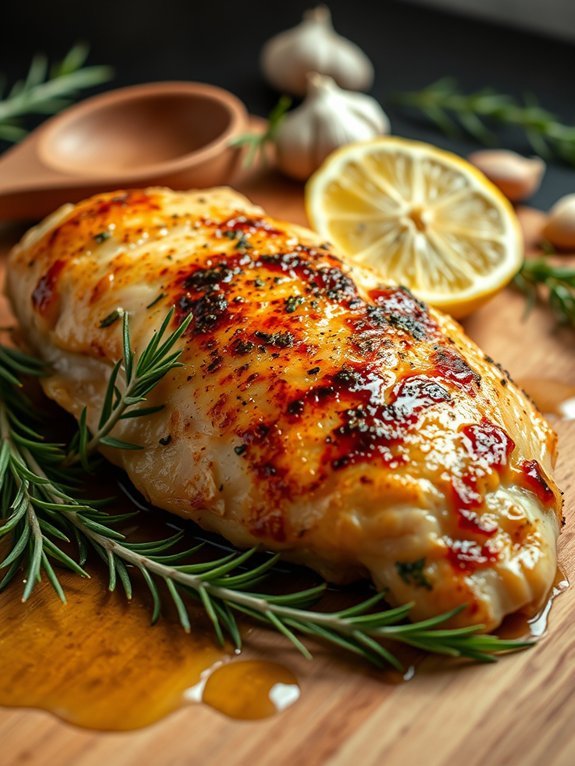
Cooking proteins to perfection can elevate any meal and turn a simple dish into a culinary masterpiece. Understanding the right techniques for each type of protein—be it chicken, beef, pork, or fish—can greatly impact the texture, flavor, and overall quality of your dish. Mastering these techniques won’t only boost your confidence in the kitchen but also impress family and friends with perfectly cooked meats that are juicy and packed with flavor.
One essential technique you should know is the importance of temperature control and resting time. Proteins should be cooked to the right internal temperature to guarantee both safety and palatability. For example, chicken should reach an internal temperature of 165°F and tender cuts of beef like steak can range from 130°F to 160°F depending on your desired level of doneness.
Additionally, letting meats rest after cooking allows juices to redistribute—making every bite juicy and flavorful.
Ingredients
- 2 chicken breasts (or alternative protein)
- Salt
- Black pepper
- 2 tablespoons olive oil
- 1 lemon (for zest and juice)
- Fresh herbs (such as thyme or rosemary)
- 2 garlic cloves, minced (optional)
Season your chosen protein generously with salt and pepper on both sides. If using chicken breasts, heat olive oil in a skillet over medium-high heat. Once hot, add the chicken breasts (or alternative protein) and sear them without moving them for about 6-7 minutes, or until a golden-brown crust forms.
Flip and reduce the heat to medium, adding minced garlic (if using) and a splash of lemon juice. Cook until they reach the desired internal temperature, about 5-7 more minutes for chicken. Remove from heat and let rest for 5-10 minutes before serving.
When cooking proteins, it’s essential to avoid overcrowding the pan as this can lead to steaming instead of searing. This will result in proteins that are neither caramelized nor crispy. For an added layer of flavor, consider marinating the proteins ahead of time or using a meat thermometer for precision cooking.
Finally, don’t rush the resting period; this step is critical for achieving a juicy and flavorful dish.
Baking Basics: From Bread to Pastries
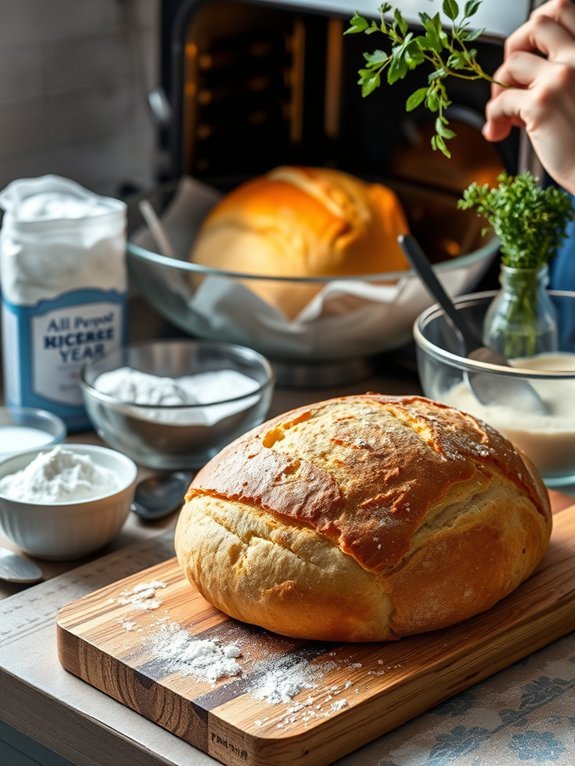
Baking is an essential kitchen skill that opens up a world of delicious possibilities. From warm, comforting bread to decadent pastries, mastering the basics of baking can transform your culinary repertoire. Each baked item comes with its unique blend of ingredients and techniques, but the foundation often revolves around a few key components: flour, sugar, fat, eggs, and leavening agents. Understanding how these ingredients work together will help you create a variety of baked goods from scratch.
Bread, for example, is a staple in many cuisines and serves as the backbone of numerous meals. While making bread can seem intimidating, with practice and the right recipe, anyone can achieve a wonderfully crusty loaf.
On the other hand, pastries require a delicate touch and precision to achieve that flaky, light texture. In this recipe, we’ll guide you through the process of making a classic white bread that’s both straightforward and satisfying to make.
- 4 cups all-purpose flour
- 2 teaspoons salt
- 2 teaspoons sugar
- 1 packet (2 ¼ teaspoons) active dry yeast
- 1 ½ cups warm water (about 110°F or 43°C)
- 2 tablespoons olive oil (optional)
In a large mixing bowl, combine the warm water, sugar, and yeast. Allow it to sit for about 5-10 minutes, or until it becomes frothy. Gradually add the flour and salt, mixing until a dough forms.
Knead the dough on a floured surface for about 10 minutes until smooth and elastic. Place the dough in a lightly greased bowl, cover with a cloth, and let it rise in a warm area for about an hour or until it has doubled in size. Punch down the dough to release the air, shape it into a loaf, and place it in a greased loaf pan.
Let it rise again for about 30 minutes before baking in a preheated oven at 375°F (190°C) for 30-35 minutes or until golden brown and sounds hollow when tapped on the bottom.
When baking bread, timing and temperature are critical. Verify your yeast is fresh and proof correctly for the best results.
Additionally, for a crustier crust, you can place a small pan of water in the oven while your bread bakes. This will create steam, which helps achieve that beautifully browned exterior. Always let your bread cool before slicing to maintain its texture.
Experiment with adding herbs, cheese, or seeds to customize your bread!
Sauces and Dressings: Elevating Your Dishes
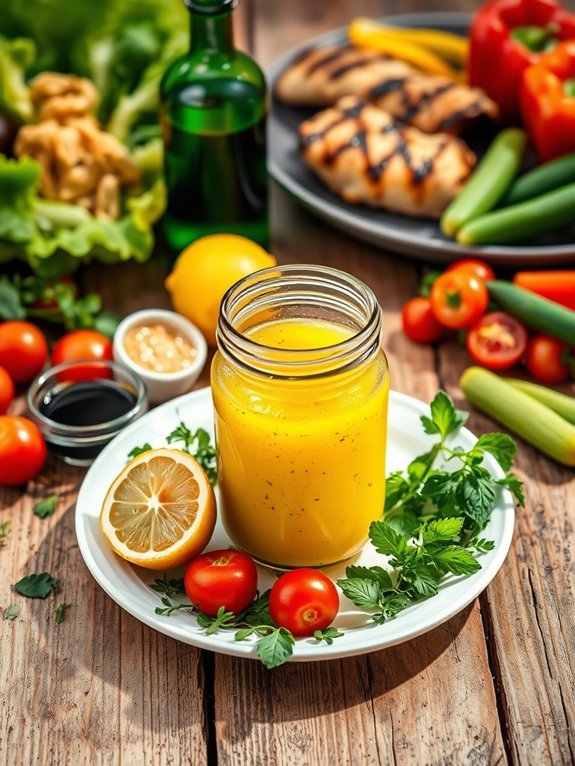
Sauces and dressings play a critical role in elevating your dishes from ordinary to extraordinary. A well-crafted sauce can enhance flavors, add richness, and provide a delightful contrast in texture.
Whether you’re preparing a gourmet feast or a simple weeknight dinner, mastering a few classic sauces will give you the confidence to experiment and create your own unique blends.
One such essential sauce is a simple yet versatile vinaigrette. This dressing not only beautifully complements salads but can also be drizzled over grilled vegetables, fish, or meats to add zest and brightness to the dish.
With just a few basic ingredients, you’ll be equipped to whip up this delicious vinaigrette in no time, elevating all your meals with its tangy flavor profile and fresh ingredients.
- 1/4 cup extra virgin olive oil
- 2 tablespoons balsamic vinegar (or red wine vinegar)
- 1 teaspoon Dijon mustard
- 1 teaspoon honey or maple syrup
- Salt and pepper, to taste
- Optional: minced garlic, fresh herbs, or shallots
In a small bowl or jar with a lid, whisk together the vinegar, Dijon mustard, and honey until well combined.
Slowly drizzle in the olive oil while whisking continuously to emulsify the dressing. If using optional ingredients, add them in and mix well.
Season with salt and pepper to taste, adjusting any flavors as desired.
When preparing dressings, remember that you can always modify the taste by adjusting the acid (like vinegar) and sweetness (like honey).
Feel free to experiment with different vinegars, oils, and flavor enhancers such as citrus juice, fresh herbs, or spices.
It’s also a good idea to let your vinaigrette sit for a bit before serving, as this allows the flavors to meld together beautifully.
Store any leftovers in an airtight container in the fridge, and give it a good shake before using again!
Understanding Food Safety and Storage
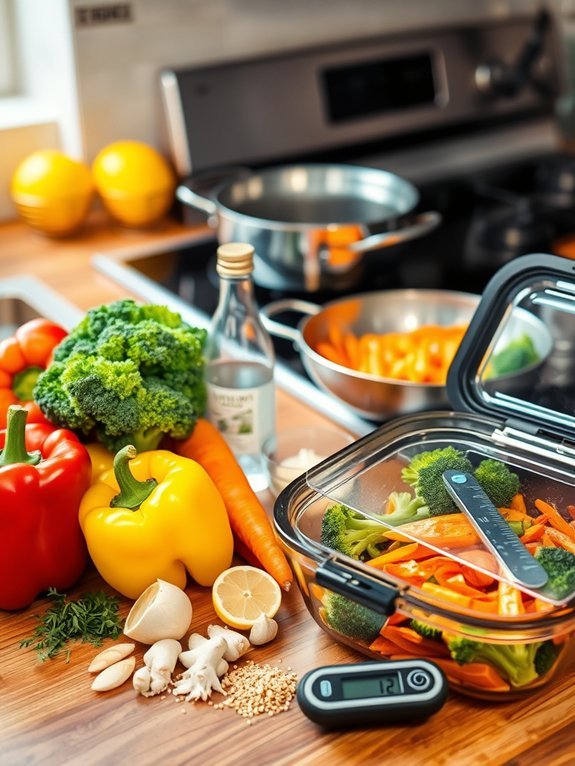
Understanding food safety and storage is crucial for any kitchen enthusiast looking to prepare delicious meals while safeguarding the health and well-being of everyone at the table. By prioritizing food safety, you reduce the risk of foodborne illnesses that can arise from improper handling and storage of ingredients. Proper techniques not only enhance the quality of your dishes but also provide peace of mind knowing that you’re following best practices.
This recipe incorporates simple yet effective food storage methods to enhance your cooking experience. In this dish, we’ll create a savory Vegetable Stir-Fry, highlighting the importance of using fresh, safe ingredients and confirming that they’re stored correctly before and after cooking.
We’ll use techniques such as washing vegetables thoroughly to remove any contaminants and storing leftovers appropriately to maintain safety. With vibrant colors and a medley of flavors, this stir-fry is both nutritious and quick to prepare, making it an ideal meal for busy weekdays.
- 2 cups of mixed fresh vegetables (bell peppers, broccoli, carrots, snap peas)
- 1 tablespoon vegetable oil
- 2 cloves garlic, minced
- 1 tablespoon ginger, minced
- 2 tablespoons soy sauce
- 1 tablespoon sesame oil
- 1 tablespoon sesame seeds (optional)
- Cooked rice or noodles for serving
Heat the vegetable oil in a large skillet or wok over medium heat. Add the minced garlic and ginger, sautéing for about 30 seconds until fragrant. Then add the mixed vegetables and stir-fry for 4-5 minutes or until they’re just tender but still crisp. Pour in the soy sauce and sesame oil, tossing everything well to combine. Cook for another 1-2 minutes, allowing the sauce to cling to the vegetables.
Serve the stir-fry over cooked rice or noodles, garnishing with sesame seeds if desired. When cooking, it’s vital to use fresh ingredients and confirm proper food safety throughout the process. Always wash your vegetables thoroughly under running water before cutting, and avoid cross-contamination by using separate cutting boards for raw and cooked foods.
After preparing your stir-fry, if you have leftovers, cool them quickly and store them in airtight containers in the refrigerator. Remember to consume leftovers within three to four days for maximum safety, and always reheat food to at least 165°F before eating again.
Creative Plating and Presentation Skills
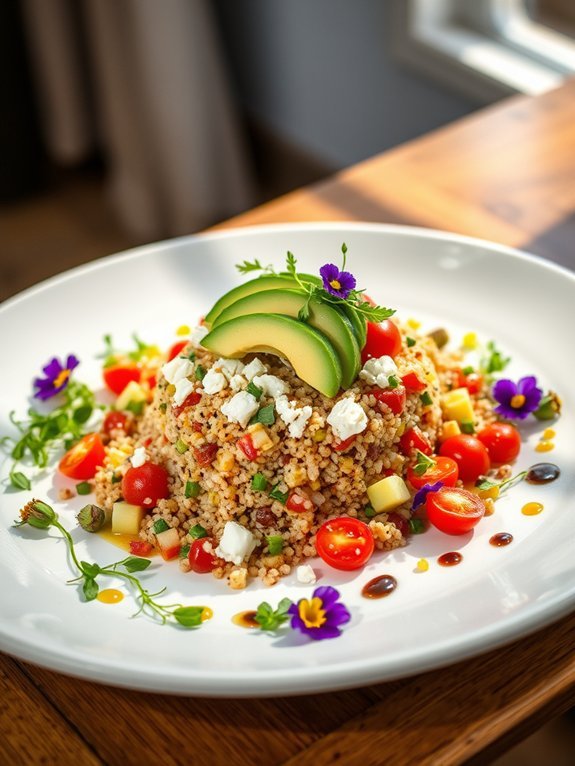
Creative plating is an art that can elevate your culinary creations and make even the simplest of dishes look gourmet. First impressions count, especially when it comes to food, so mastering the skill of plating can transform your dining experience. Whether you’re hosting a dinner party or enjoying a quiet meal at home, the way you present your dish can enhance the flavors and make each bite more enjoyable. Think of your plate as a canvas and your food as the paint—how can you make a masterpiece?
Consider the colors, textures, and shapes of the ingredients when planning your plating. A dish with a variety of colors and textures is always more appealing to the eye. Use contrasting colors—such as vibrant greens alongside deep reds—to create visual interest. Additionally, pay attention to height; a dish that’s layered vertically can draw the eye upward.
Ultimately, garnishing is key—small touches like microgreens, edible flowers, or a drizzle of sauce can make a world of difference in the presentation.
- 1 cup cooked quinoa
- 1 cup cherry tomatoes, halved
- ½ cup cucumber, diced
- ¼ cup red onion, finely chopped
- 1 avocado, sliced
- ¼ cup feta cheese, crumbled
- 2 tablespoons olive oil
- Juice of 1 lemon
- Salt and pepper to taste
- Fresh herbs for garnish (e.g., basil or parsley)
To prepare your dish, start by combining the quinoa, cherry tomatoes, cucumber, and red onion in a bowl. Drizzle with olive oil and lemon juice, then season with salt and pepper. Gently toss to mix all the ingredients well.
Next, arrange a generous scoop of the quinoa salad in the center of a large, white plate to create a base. Artfully layer the avocado slices over the quinoa, top with feta cheese, and scatter some fresh herbs as a final touch of color. Be mindful of the placement and proportions to achieve an aesthetically pleasing look.
When it comes to plating, remember that less is often more. Avoid overcrowding the plate; instead, allow your colorful ingredients to breathe. Use a spoon or squeeze bottle for sauces to create elegant drizzles or dots around the plate. Keep your edges clean, wiping off any spills or smudges for a polished finish.
Ultimately, don’t be afraid to practice! Experiment with different arrangements and styles until you find what works best for your dish and personal taste.

